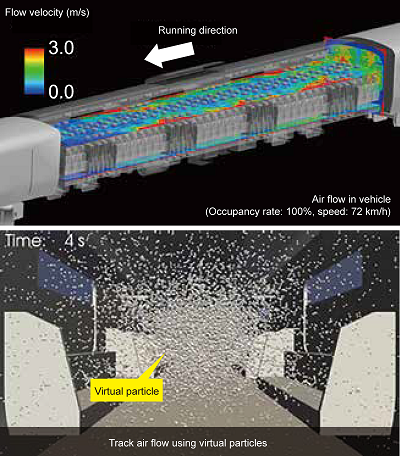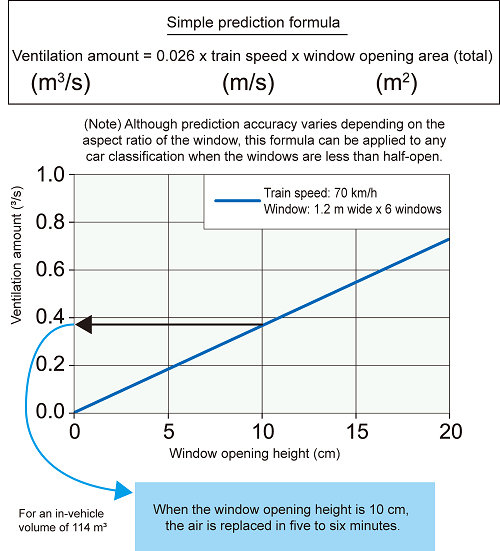22. Numerical simulation of ventilation in a vehicle by opening windows while running
One of the countermeasures against infectious diseases in commuter vehicles is to ventilate a vehicle by opening windows as one of the "closed space" countermeasures, and a quantitative evaluation of the ventilation amount is required. To address this issue, we have developed a numerical simulation tool that can predict the amount of ventilation in a vehicle by opening windows while running. In addition, by organizing the results of predicting the ventilation amount under various conditions, we have proposed a simple formula for predicting the ventilation amount.
The simulation of ventilation in a vehicle has been realized by introducing a function to evaluate ventilation amount to the previously developed fluid analysis tool "Airflow Simulator" (Fig. 1). The simulation calculates the air flow outside and inside the vehicle at the same time. In doing so, the ventilation amount is evaluated by tracking the air flow using virtual particles generated continuously at 114 locations in the vehicle. The window opening height, seating arrangement, passenger position, etc. are variable, allowing the prediction of the ventilation amount under any given condition. We have confirmed that the simulation results are generally consistent with on-track test results.
The simulations revealed that the ventilation amount is proportional to the train speed and window opening area and that there is no significant difference depending on the occupancy rate or seating arrangement when the window opening height is less than half-open. Based on this knowledge, we have also proposed a simple prediction formula for ventilation amount (Fig. 2). This prediction formula can be used to evaluate the measures against "closed space" for railway vehicles, such as setting the amount of window opening according to the window shape.
Other Contents
- 22. Numerical simulation of ventilation in a vehicle by opening windows while running
- 23. Analytical evaluation method for the speed at which hunting occurs
- 24. Evaluation of the influence of wheel machining marks on the friction coefficient by visualizing the contact area
- 25. Wheel slide protection simulator to supplement on-track testing
- 26. Non-contact method to detect rail openings using aerial ultrasonic waves
- 27. Clarification of wear mechanism of current collecting materials caused by frictional heat
- 28. Method to evaluate physical properties of frictional materials by numerical simulation
- 29. Detection of changes in drivers' physical and mental state using physiological indicators
- 22. Numerical simulation of ventilation in a vehicle by opening windows while running
- 23. Analytical evaluation method for the speed at which hunting occurs
- 24. Evaluation of the influence of wheel machining marks on the friction coefficient by visualizing the contact area
- 25. Wheel slide protection simulator to supplement on-track testing
- 26. Non-contact method to detect rail openings using aerial ultrasonic waves
- 27. Clarification of wear mechanism of current collecting materials caused by frictional heat
- 28. Method to evaluate physical properties of frictional materials by numerical simulation
- 29. Detection of changes in drivers' physical and mental state using physiological indicators


